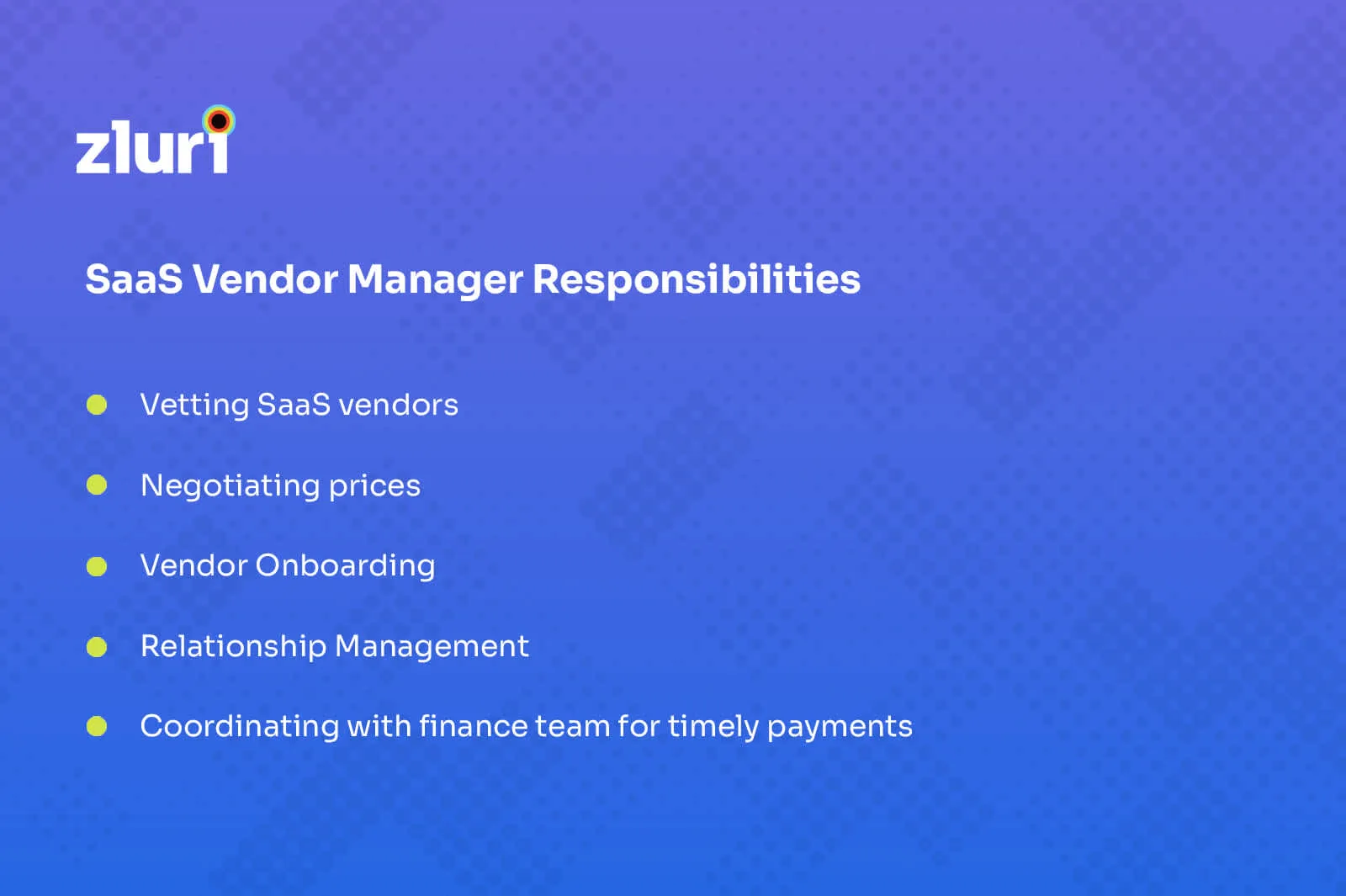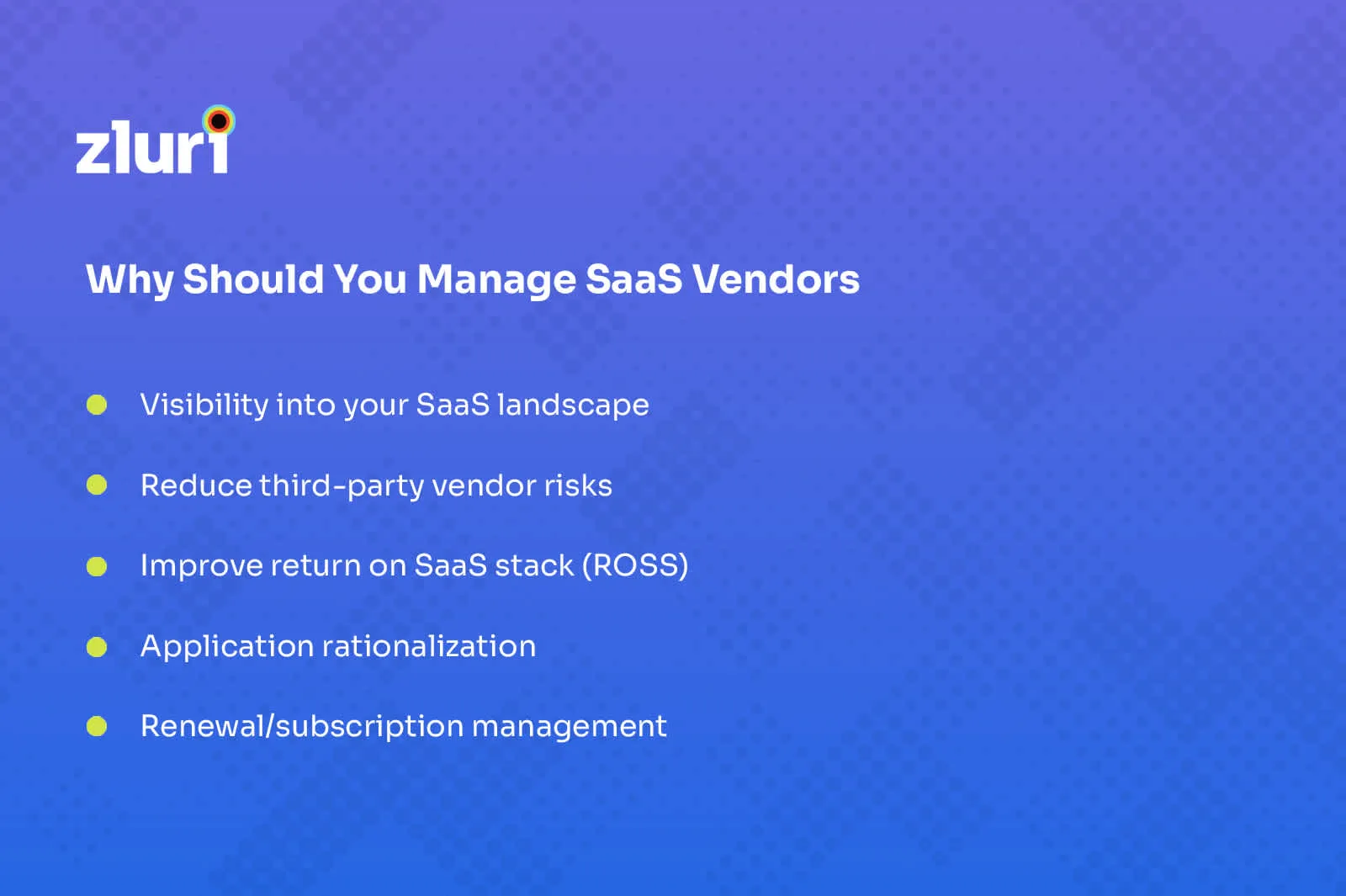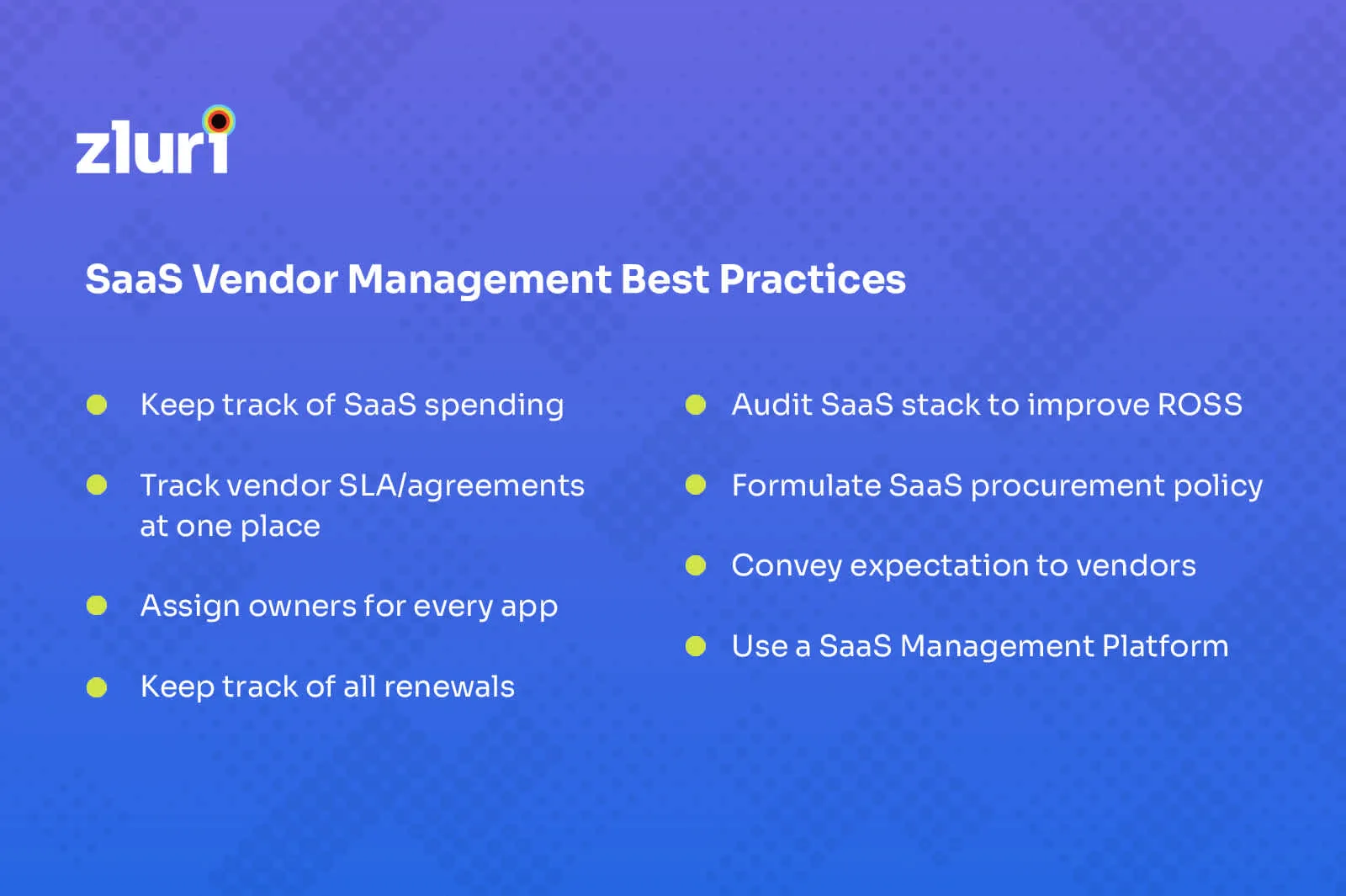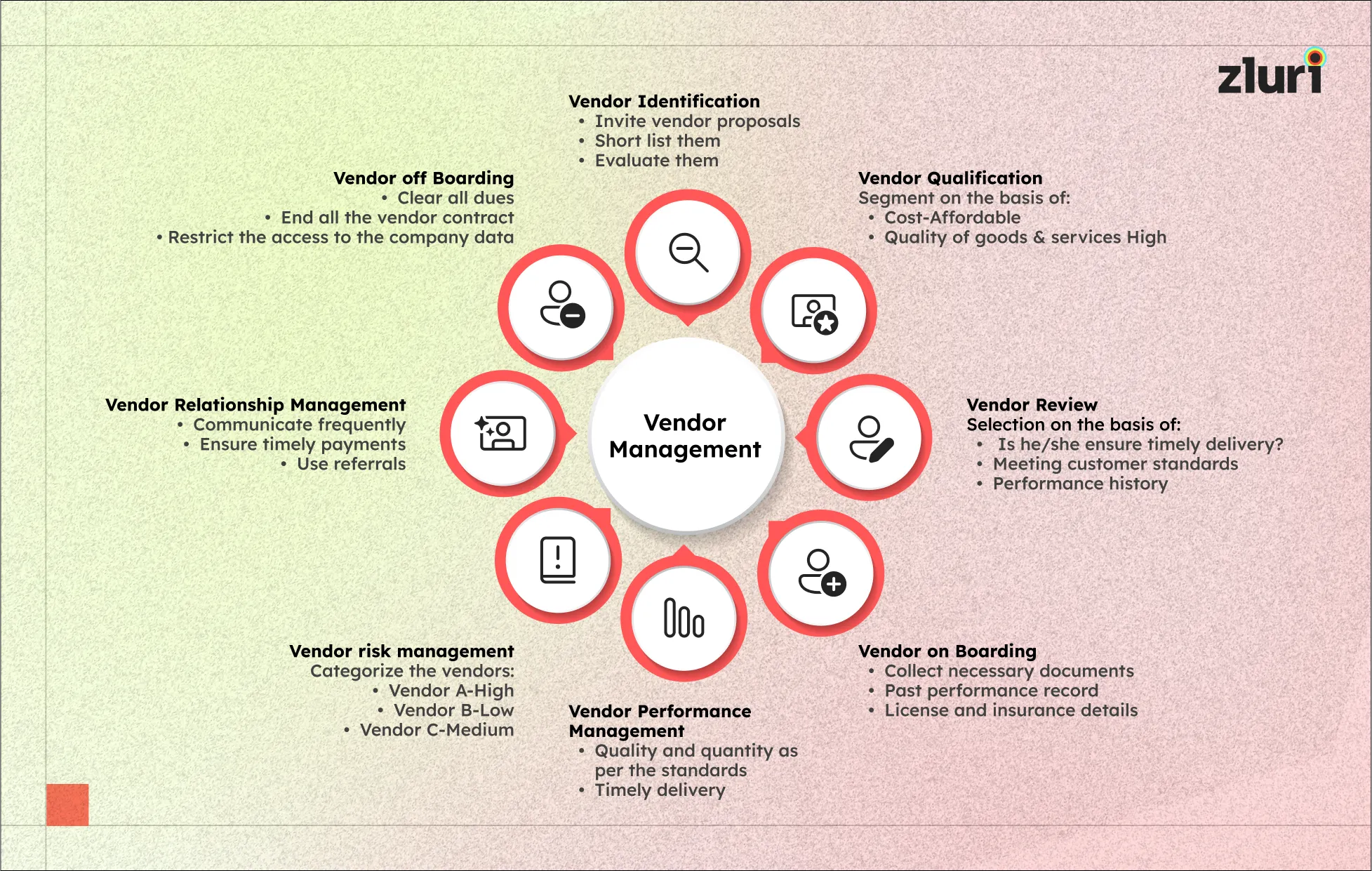As SaaS applications increase, managing multiple vendors, contracts, and performance metrics can become overwhelming. Effective SaaS vendor management is essential to tackle these challenges. This guide offers practical tips and best practices for managing your SaaS vendors effectively.
Managing multiple SaaS vendors often leads to issues like redundant applications, underutilized subscriptions, and escalating costs. These challenges can strain your IT budget and complicate your efforts to maintain a streamlined and secure IT environment.
Addressing these problems might be challenging without a robust SaaS vendor management strategy. Therefore, by implementing a structured approach, you can gain better control over your SaaS ecosystem, optimize costs, and ensure that each application aligns with your organizational goals.
But what exactly is SaaS vendor management? Let's explore.
What is SaaS Vendor Management?
In concise terms, SaaS vendor management refers to the process of identifying, selecting, and effectively overseeing SaaS providers to meet your organization's specific needs.
SaaS vendor management revolves around making informed decisions when selecting SaaS providers, optimizing vendor relationships to drive value and efficiency, and mitigating risks to ensure the smooth operation of your organization's software applications.
Responsibilities of a SaaS Vendor Manager
SaaS vendor managers are crucial in providing their organizations with the necessary tools to thrive in the modern business environment.

Their core responsibilities are:
- Vendor Selection: In a market flooded with SaaS applications, vendor managers must carefully evaluate and choose vendors that best meet their organization's specific needs. This involves thorough assessment to find the ideal solutions among numerous options.
- Price Negotiations: Effective budget management is key for vendor managers. They actively negotiate pricing terms to secure the best deals. If expenses exceed the budget, they must provide justifications and explanations.
- Vendor Onboarding Process: Once a contract is finalized, vendor managers oversee the integration of the vendor's software solutions into the organization. This includes ensuring a smooth onboarding process and managing the vendor lifecycle.
- Ongoing Relationship Management: Maintaining strong relationships with vendors is essential. Vendor managers regularly communicate with vendors to address changing requirements, seek assistance, and coordinate employee training sessions to maximize product value.
- Invoicing and Payments: Ensuring timely renewal of software services is a key responsibility. Vendor managers work with finance and HR departments to handle renewals and payments, preventing any disruptions in service delivery.
Why You Need to Manage SaaS Vendors?

SaaS vendor management is a crucial component of SaaS governance. It is essential for CIOs and you to recognize the significance of incorporating SaaS vendor management into their overall IT strategy.
1. For Greater Visibility
Companies often adopt SaaS applications to streamline their operations. Effective SaaS vendor management ensures the efficient oversight of these applications while concurrently providing enhanced transparency into procurement activities. This visibility empowers you to make informed decisions regarding the retention or reduction of specific applications that may be considered redundant or underutilized.
Robust vendor management simplifies the process by serving as a centralized repository for managing vendor relationships, contracts, and forthcoming expenditures. Consequently, you can eliminate unnecessary applications, opting to retain those with optimal functionality. This prudent approach results in cost savings and yields a positive return on investment.
Moreover, by offering real-time insights into the state of your SaaS ecosystem, effective vendor management enables proactive measures against the proliferation of shadow IT applications, thus ensuring better governance and cost control.
2. Mitigating Third-Party Vendor Risks
When employees utilize company email addresses to subscribe to applications, they inadvertently expose sensitive corporate information online. Given the increasing prevalence of shadow IT, it becomes challenging to discern trustworthy vendors, potentially exposing the organization to phishing and Distributed Denial of Service (DDoS) attacks.
By implementing strong vendor management protocols, you can gain a comprehensive overview of all subscribed applications from a centralized platform, enabling them to identify the primary contributors to these subscriptions.
This centralized oversight facilitates the implementation of training programs for app owners and employees, imparting best practices for safeguarding sensitive data.
3. To Improve Your Return on SaaS Stack (ROSS)
If your organization purchases SaaS apps from multiple vendors, you are most likely to purchase technologies with similar features.
For example, two different departments using different tools for the same functionality. Your marketing department uses Slack for communication, whereas your finance team uses Teams.
Vendor management software serves as a strategic compass in identifying these overlapping functionalities. This invaluable feature allows organizations to strategically consolidate redundant applications, leading to substantial cost savings and an optimized SaaS ecosystem.
4. For Effective Application Rationalization
Vendor management software is a powerful catalyst for streamlining the existing SaaS stack. Its primary aim is to enhance operational efficiency, reduce complexity, and curtail unnecessary expenditures. It empowers organizations to make informed decisions about their software investments.
In doing so, they can harness the full potential of their SaaS stack while minimizing risks and maximizing returns. Effective application rationalization through vendor management software is not just a cost-saving measure; it's a strategic imperative for modern businesses.
5. Proactive Renewal Management
A SaaS vendor management tool extends its value by providing timely notifications concerning application changes, including upcoming renewal dates. With comprehensive usage metrics, organizations can make informed decisions, choosing to renew or gracefully retire contracts.
Furthermore, your teams can ascertain the cost implications of renewing an application, thereby evaluating its alignment with budgetary constraints. This proactive renewal management strategy empowers you to avoid last-minute budget surprises, fostering financial prudence and stability, all thanks to the robust capabilities of vendor management software.
6. Reduces the IT Admin Burden
Traditionally, the onus of managing the SaaS stack has rested on the shoulders of IT administrators, who often rely on laborious spreadsheets for tracking applications. Vendor management tools usher in a transformative paradigm shift. These tools unlock tremendous time and cost-saving potentials by facilitating real-time analysis of transaction data for each application.
For instance, you can systematically segregate unused or underutilized applications and make data-driven decisions regarding their continued relevance and subscription. This efficient and data-backed approach lightens the administrative load on IT teams and enhances operational efficiency and fiscal responsibility.
SaaS Vendor Management Best Practices
Building and maintaining relationships with your SaaS vendors can be instrumental in securing better deals during renewals and optimizing your software portfolio.

Here are some best practices for SaaS vendor management:
- Keep track of SaaS spending: A comprehensive record of SaaS expenditures across different business units, teams, and individual users. Categorize and report spending by departments and specific categories to gain better insights into your SaaS expenses.
- Keep track of SLAs & contracts/agreements in one place: Ensure all documentation related to SLAs and contracts is kept in one place.
When breaches in the vendor agreement terms are identified, consult with your CIO or IT head to determine the appropriate course of action, which may include seeking compensation as per the terms, terminating the current contract, or negotiating discounts for the next renewal. - Assign owners for every app: Given the decentralized acquisition and utilization of SaaS applications, it becomes impractical to manage everything independently. A practical approach is to delegate ownership responsibilities to department or business unit heads.
- Keep track of all renewals: It is crucial to monitor all renewals. If auto-renewal is enabled, renewals can occur without the app owner's awareness.
In some cases, the app owner may unknowingly continue to incur charges for a tool they no longer utilize. Alternatively, they might be billed for a formerly free tool that has transitioned to a paid subscription after a trial period. This results in unnecessary expenditure.
To prevent such scenarios, it is advisable to centralize contract and vendor renewals in one location. This ensures that no renewals are overlooked, helping you to maintain cost efficiency and transparency in your operations. - Conduct a SaaS Stack Audit to Enhance Return on Software Spending (ROSS): In environments boasting a plethora of SaaS tools in their inventory, IT leaders should institute biannual audits to optimize utilization. To facilitate this audit process effectively, you can forge partnerships with end-users and application owners.
Consider deploying a structured survey featuring inquiries such as:
- Which applications see daily usage?
- Are there any paid subscriptions that remain unused?
- Do redundant applications exist?
- Are there free alternatives that can replace paid tools?
Through these audits, you can gain valuable insights into your SaaS stack's overall health and efficiency, contributing to an enhanced Return on Software Spending (ROSS).
- Formulate SaaS procurement policy: Many organizations lack a well-defined procedure for acquiring SaaS applications. Often, employees acquire new technology solutions without conducting prior vendor research simply by using the company credit card. This lack of a structured approach poses significant challenges.
A documented SaaS procurement process enables employees to choose the most suitable solution for their needs and aids in mitigating Shadow IT issues. This procurement process should outline how employees can request new software, establish security and legal assessment criteria, designate responsible ownership, and specify individuals responsible for negotiating prices and contract terms.
Implementing such a policy can result in substantial cost savings and prevent hasty and ill-advised purchases, ultimately benefiting your business. - Clearly convey your expectations to vendors: Articulate your objectives and the specific challenges you intend to address through their product or service. Engage in a comprehensive discussion regarding payment arrangements and establish contingency plans in the event your expectations are not fulfilled. It is imperative to avoid vendor lock-in scenarios when dealing with SaaS providers under any circumstances.
- Utilize a SaaS management platform: Tracking price changes for specific applications can become cumbersome when dealing with a multitude of ongoing auto-renewals. To effectively manage renewals and licenses, you require robust technology integrated with automation to ensure proactive management. Embracing a SaaS management platform is essential for streamlining vendor management processes.
Checklist for Managing SaaS Vendors
Now, let's discuss the effective checklist for SaaS vendor management.
- Assess Your Needs: Before subscribing to a SaaS solution, it is crucial to engage with your teams and identify their specific pain points. Determine the required features, who will utilize them, and the problems to be addressed.
- Review Current Vendors: Regularly review your existing SaaS tools. These platforms often receive updates and new features. Before considering a new solution, check if your current vendors have incorporated the features you need. This approach can lead to cost savings.
- Evaluate All Options: The SaaS market offers a multitude of choices. When selecting a SaaS vendor, prioritize factors such as cost-effectiveness, reliability, and security. Be cautious not to blindly trust vendors solely based on lower prices.
- Compare before swiping your corporate card: Take the time to compare different vendors' offerings. Analyze reports from reputable sources like Gartner and Forrester for insights into software rankings and software costs. Seek advice from peers in similar industries who are already using comparable software. Additionally, consult review sites like G2, Capterra, and Product Hunt for user feedback.
- Trial period: Before committing, narrow down your options and conduct trials of the selected SaaS solutions. This step lets you assess whether the software aligns with your business goals and requirements.
- Vendor Approval: Approving a vendor can be time-consuming, but efficiency can be improved with established processes. Key considerations during vendor approval should encompass privacy terms and conditions, pricing and contract terms, security risk assessments, annual budget impact, regulatory compliance, and final contract signing.
- Application Rollout: After contract signing, designate an internal owner responsible for managing any issues related to the application or the vendor relationship. Collaborate closely with the IT department to identify users utilizing the software and ensure seamless integration with your existing SaaS stack. Implement a secure onboarding process and address any vulnerabilities.
- Vendor Documentation: The assigned owner should maintain and manage all vendor details. This includes tracking contract agreements, responsibilities, and any associated communication.
- Renew or Terminate: As the renewal date approaches, carefully evaluate the contract based on consumption and return on investment (ROI). Setting renewal notifications 2-3 months in advance is advisable to allow sufficient time for decision-making. Determine whether to continue with the contract or consider termination based on your organization's evolving needs.
By following this comprehensive checklist, you can effectively manage your SaaS vendor relationships and optimize your software investments.
Implement a SaaS Management Platform for Effective Vendor Management
Implementing a SaaS management platform for effective vendor management is essential in today's technology-driven business landscape. It simplifies the management of vendor contracts, enhances access control, provides timely notifications, optimizes your SaaS portfolio, automates routine tasks, supports data-driven decision-making, and helps with compliance and risk mitigation.
However, numerous SaaS management tools are available in the marketplace. One such platform is Zluri. Zluri offers a SaaS management platform with an inbuilt automated SaaS vendor management system and all the features needed to manage your SaaS stack.
Zluri helps your organization gain visibility and control of the changing tech stack. It integrates with your core business system to maintain a SaaS system of record, after which it prepares to manage your vendor life cycle with your predefined workflows.

These benefits collectively contribute to cost savings, improved efficiency, and better overall vendor relationship management. Certain tips will help ensure a successful vendor management system (VMS) implementation.
But how do you choose a SaaS management platform that resonates with your business goals? Let's explore.
How to Select a SaaS Management Platform for Managing Vendors?
Here are the key factors to consider when selecting an SMP for effectively managing vendors and their associated SaaS apps:
1. Number of Seats per App: Some SaaS apps charge based on monthly users (seats).
An SMP helps you keep track of active users for each app, ensuring accurate billing.
For example, if you've licensed a project management tool for 50 users, the SMP ensures you're not paying for unused seats.
2. Cost per Subscription: Understanding subscription costs is vital for cost optimization.
Your SMP consolidates subscription cost data, allowing you to spot cost-effective alternatives.
For instance, it can highlight if Vendor A offers services similar to Vendor B but at a lower cost, helping you make informed decisions.
3. Renewal Dates: Manually tracking renewal dates for numerous SaaS applications is tedious.
An SMP provides automated renewal alerts, giving you time to assess whether you still need specific applications based on usage.
For instance, if a rarely used analytics tool is up for renewal, the SMP helps you decide whether to keep it to save costs.
4. Application Owners: Knowing who's responsible for each application streamlines communication and issue resolution. Your SMP makes it easy to identify the application owner, ensuring quick access when you need to resolve problems or seek support.
5. Compliance Status: Ensuring SaaS applications comply with industry standards is essential for data security. The SMP should display compliance information, helping you verify if an app meets your organization's security and regulatory requirements.
For instance, it ensures healthcare data management tools adhere to HIPAA regulations for healthcare organizations.
6. Onboarding, Offboarding, Security, and Privacy: Efficiently managing user access during onboarding and offboarding is crucial for security and cost control. An ideal SMP streamlines the process. It ensures new employees access necessary tools immediately while keeping license counts accurate.
When employees leave, the SMP automates access termination and license suspension, reducing security risks and unnecessary spending on unused licenses.
One such platform that is a go-to solution for all your vendor management needs is Zluri. It is a comprehensive platform designed to simplify and enhance the vendor management process by automating key tasks related to SaaS vendor management. Here's how Zluri helps you achieve effective vendor management:
Revolutionize SaaS Vendor Management with Automation
Embracing automation in SaaS vendor management can significantly transform how IT managers manage their software ecosystems. Automation tools can help streamline subscription tracking, optimize usage, and ensure compliance effortlessly. By leveraging these tools, you can eliminate the manual, time-consuming processes that often lead to errors and inefficiencies. This shift saves time and enhances accuracy and control over your SaaS investments.
Automated SaaS vendor management lets you gain real-time insights into your software usage and costs. This makes identifying and addressing issues such as unused subscriptions and overlapping tools easier. With a more efficient and transparent system in place, you can negotiate better terms with vendors and maintain a secure, compliant IT environment. Ultimately, automating your SaaS vendor management will empower you to drive greater efficiency, reduce costs, and support your organization's strategic goals with confidence.









.svg)














